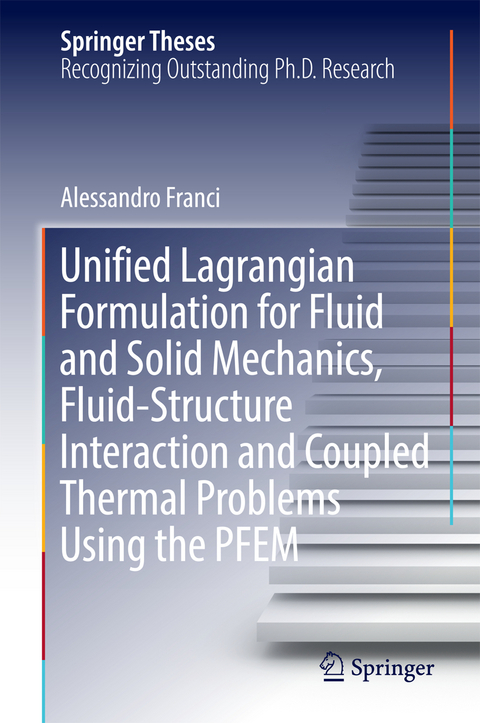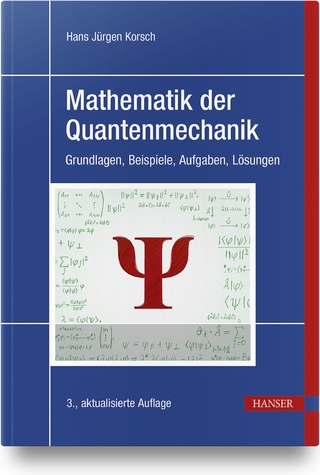
Unified Lagrangian Formulation for Fluid and Solid Mechanics, Fluid-Structure Interaction and Coupled Thermal Problems Using the PFEM
Springer International Publishing (Verlag)
978-3-319-45661-4 (ISBN)
This book treats the derivation and implementation of a unified particle finite element formulation for the solution of fluid and solid mechanics, Fluid-Structure Interaction (FSI) and coupled thermal problems.
FSI problems are involved in many engineering branches, from aeronautics to civil and biomedical engineering. The numerical method proposed in this book has been designed to deal with a large part of these. In particular, it is capable of simulating accurately free-surface fluids interacting with structures that may undergo large displacements, suffer from thermo-plastic deformations and even melt. The method accuracy has been successfully verified in several numerical examples. The thesis also contains the application of the proposed numerical strategy for the simulation of a real industrial problem.
This thesis, defended at the Universitat Politecnica de Catalunya in 2015, was selected (ex aequo) as the best PhD thesis in numerical methods in Spain for theyear 2015 by the Spanish Society of Numerical Methods in Engineering (SEMNI).
1 Introduction.- 1.1 Objectives.- 1.2 State of the art.- 1.2.1 Eulerian and Lagrangian approaches for free surface flow analysis .- 1.2.2 Stabilization techniques.- 1.2.3 Algorithms for FSI problems.- 1.3 Numerical model.- 1.3.1 Reasons.- 1.3.2 Essential features.- 1.3.3 Outline.- 1.4 Publications.- 2 Velocity-based formulations for compressible materials.- 2.1 Velocity formulation.- 2.1.1 From the local form to the spatial semi-discretization.- 2.1.2 Time integration.- 2.1.3 Linearization.- 2.1.4 Incremental solution scheme.- 2.2 Mixed velocity-pressure formulation.- 2.2.1 Quasi-incompressible form of the continuity equation.- 2.2.2 Solution method.- 2.3 Hypoelasticity.- 2.3.1 Velocity formulation for hypoelastic solids.- 2.3.2 Mixed Velocity-Pressure formulation for hypoelastic solids.- 2.3.3 Theory of plasticity.- 2.3.3.1 Hypoelastic-plastic materials.- 2.3.4 Validation examples.- 2.4 Summary and conclusions.- 3 Unified stabilized formulation for quasi-incompressible materials.- 3.1Stabilized FIC form of the mass balance equation.- 3.1.1 Governing equations.- 3.1.2 FIC mass balance equation in space and in time.- 3.1.3 FIC stabilized local form of the mass balance equation.- 3.1.4 Variational form.- 3.1.5 FEM discretization and matrix form.- 3.2 Solution scheme for quasi-incompressible Newtonian fluids.- 3.2.1 Governing equations.- 3.2.2 Solution scheme.- 3.3 Solution scheme for quasi-incompressible hypoelastic solids.- 3.4 Free surface flow analysis.- 3.4.1 The Partiele Finite Element Method.- 3.4.1.1 Remeshing.- 3.4.1.2 Basic steps.- 3.4.1.3 Advantages and disadvantages.- 3.4.2 Mass conservation analysis.- 3.4.2.1 Numerical examples.- 3.4.3 Analysis of the conditioning of the solution scheme.- 3.4.3.1 Drawbacks associated to the real bulk modulus.- 3.4.3.2 Optimum value for the pseudo bulk modulus.- 3.4.3.3 Numerical examples.- 3.5 Validation examples.- 3.5.1 Validation of the Unified formulation for Newtonian fluids.- 3.5.2 Validation of the Unified formulation for quasi-incompressible hypoelastic solids.- 3.6 Summary and conclusions.- 4 Unified formulation for F SI problems.- 4.1 Introduction.- 4.2 FSI algorithm.- 4.3 Coupling with the Velocity formulation for the solid.- 4.4 Coupling with the mixed Velocity-Pressure formulation for the solid.- 4.5 Numerical examples.- 4.6 Summary and conclusions.- 5 Coupled thermal-mechanical formulation.- 5.1 Introduction.- 5.2 Heat problem.- 5.2.1 FEM discretization and solution for a time step.- 5.3 Thermal coupling.- 5.3.1 Numerical examples.- 5.4 Phase change.- 5.4.1 Numerical example: melting of an ice block.- 5.5 Summary and conclusions.- 6 Industrial application: PFEM Analysis Model of NPP Severe Accident.- 6.1 Introduction.- 6.1.1 Assumptions allowed by the specification.- 6.2 Numerical method.- 6.3 Basic Model.- 6.3.1 Problem data.- 6.3.2 Preliminary study.- 6.3.3 Numerical results.- 6.4 Detailed model.- 6.4.1 Problem data.- 6.4.2 Preliminary study.- 6.4.3 Numerical results.- 6.5 Summary and conclusions.- 7 Conclusions and future lines of research.- 7.1 Contributions.- 7.2 Lines for future work.
"This book treats the derivation and implementation of a unified particle finite element formulation for the solution of problems in fluid and solid mechanics, fluid-solid interaction (FSI) and coupled thermal problems. ... The book is well-prepared and can be used as one of the basic reference sources for researchers working in the area of numerical solutions of fluids, solids and FSI problems." (Hilmi Demiray, zbMATH, Vol. 1366.76001, 2017)
| Erscheinungsdatum | 25.10.2016 |
|---|---|
| Reihe/Serie | Springer Theses |
| Zusatzinfo | XIX, 211 p. 168 illus., 147 illus. in color. |
| Verlagsort | Cham |
| Sprache | englisch |
| Maße | 155 x 235 mm |
| Themenwelt | Mathematik / Informatik ► Mathematik ► Analysis |
| Mathematik / Informatik ► Mathematik ► Angewandte Mathematik | |
| Mathematik / Informatik ► Mathematik ► Wahrscheinlichkeit / Kombinatorik | |
| Technik ► Maschinenbau | |
| Schlagworte | computational science and engineering • Continuum Mechanics and Mechanics of Materials • Engineering • engineering fluid dynamics • Fluid-structure Interaction (FSI) • Free-surface fluids • Lagrangian formulation • Maths for scientists • Mechanical engineering and materials • Mechanics of Fluids • Particle Finite Element Method (PFEM) • SEMNI • Sociedad Española de Métodos Númericos en IngenierÃa • Sociedad Española de Métodos Númericos en Ingenier • Sociedad Española de Métodos Númericos en Ingeniería • Thermal coupling • Thesis |
| ISBN-10 | 3-319-45661-X / 331945661X |
| ISBN-13 | 978-3-319-45661-4 / 9783319456614 |
| Zustand | Neuware |
| Haben Sie eine Frage zum Produkt? |
aus dem Bereich


